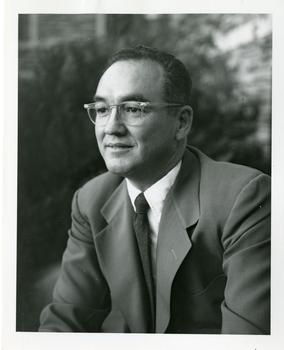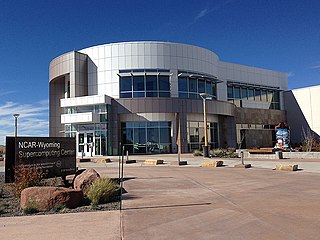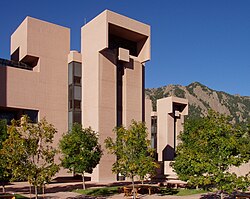
Ieoh Ming Pei was a Chinese-American architect. Born in Guangzhou into a Chinese family, Pei drew inspiration at an early age from the garden villas at Suzhou, the traditional retreat of the scholar-gentry to which his family belonged. In 1935, he moved to the United States and enrolled in the University of Pennsylvania's architecture school, but quickly transferred to the Massachusetts Institute of Technology. Unhappy with the focus on Beaux-Arts architecture at both schools, he spent his free time researching emerging architects, especially Le Corbusier.

The Laboratory for Atmospheric and Space Physics (LASP) is a research organization at the University of Colorado Boulder. LASP is a research institute with over one hundred research scientists ranging in fields from solar influences, to Earth's and other planetary atmospherics processes, space weather, space plasma and dusty plasma physics. LASP has advanced technical capabilities specializing in designing, building, and operating spacecraft and spacecraft instruments.
The University Corporation for Atmospheric Research (UCAR) is a US nonprofit consortium of more than 100 colleges and universities providing research and training in the atmospheric and related sciences. UCAR manages the National Center for Atmospheric Research (NCAR) and provides additional services to strengthen and support research and education through its community programs. Its headquarters, in Boulder, Colorado, include NCAR's Mesa Laboratory, designed by I.M. Pei.

The US National Center for Atmospheric Research is a US federally funded research and development center (FFRDC) managed by the nonprofit University Corporation for Atmospheric Research (UCAR) and funded by the National Science Foundation (NSF). NCAR has multiple facilities, including the I. M. Pei-designed Mesa Laboratory headquarters in Boulder, Colorado. Studies include meteorology, climate science, atmospheric chemistry, solar-terrestrial interactions, environmental and societal impacts.

Walter Orr Roberts was an American astronomer and atmospheric physicist, as well as an educator, philanthropist, and builder. He founded the National Center for Atmospheric Research and took a personal research interest for many years in the study of influences of the Sun on weather and climate.
The High Altitude Observatory (HAO) is a laboratory of the US National Center for Atmospheric Research (NCAR). HAO operates the Mauna Loa Solar Observatory on Hawaii and a research institute in Boulder, Colorado.
Roger Willis Daley was a British meteorologist known particularly for his work on data assimilation.
Charles Allan Haertling was an American architect, whose works often combined elements of modernism and organic architecture. He is best known for his distinctive residential projects in and around Boulder and Denver, Colorado.

Warren Morton Washington was an American atmospheric scientist, a chair of the National Science Board, and a Distinguished Scholar at the National Center for Atmospheric Research (NCAR) in Boulder, Colorado. His research was part of the United Nations Intergovernmental Panel on Climate Change that shared the 2007 Nobel Peace Prize with Al Gore. In 2019, he was awarded the Tyler Prize for Environmental Achievement.
Antonio Busalacchi Jr. is the eighth president of the Boulder, Colorado-based University Corporation for Atmospheric Research. He began serving as UCAR president in August 2016.
The David E. Skaggs Research Center (DSRC) is a 372,000-square-foot (34,600 m2) research and office facility for the National Oceanic and Atmospheric Administration (NOAA), located in Boulder, CO. The building includes 698 offices, 20 conference rooms, 98 laboratories and three major computer centers, and has been designed by Fentress Architects.

Yellowstone was the inaugural supercomputer at the NCAR-Wyoming Supercomputing Center (NWSC) in Cheyenne, Wyoming. It was installed, tested, and readied for production in the summer of 2012. The Yellowstone supercomputing cluster was decommissioned on December 31, 2017, being replaced by its successor Cheyenne.

The NCAR-Wyoming Supercomputing Center (NWSC) is a high-performance computing (HPC) and data archival facility located in Cheyenne, Wyoming, that provides advanced computing services to researchers in the Earth system sciences.
Emily CoBabe-Ammann is an earth scientist who specializes in strategies for science and education initiatives. She is currently the Senior Advisor to the Vice Chancellor for Research and Innovation at the University of Colorado, at Boulder. In that capacity, she is currently the Acting Executive Associate Director for the Center for National Security Initiatives, helping the university established its classified research program. In addition, she is the managing partner for Climate Strategies, a climate data company. Previously, she served as the director of the UCAR Community Programs at the University Corporation for Atmospheric Research (UCAR) in Boulder, Colorado.

Timothy Laurence Killeen is a British and American geophysicist, space physicist, professor, and university administrator. Killeen took office as the president of the University of Illinois system in 2015. He has been the principal investigator on research projects for NASA and the National Science Foundation. Killeen has authored more than 150 publications in peer-reviewed journals as well as more than 300 other publications and papers. He has served on various White House committees and task forces and is a past editor-in-chief of the Journal of Atmospheric and Solar-Terrestrial Physics.
Francis Patton Bretherton was an applied mathematician and a professor emeritus of the Department of Atmospheric and Oceanic Sciences at the University of Wisconsin, Madison.

Everette Joseph is an American atmospheric scientist who serves as the director of the National Center for Atmospheric Research (NCAR) in Boulder, Colorado.
Annick Gabrielle Pouquet is a computational plasma physicist specializing in plasma turbulence. She was awarded the 2020 Hannes Alfvén Prize for "fundamental contributions to quantifying energy transfer in magneto-fluid turbulence". She currently holds positions in the Laboratory for Atmospheric and Space Physics and National Center for Atmospheric Research at the University of Colorado Boulder.

Makenzie Lystrup is an American planetary scientist and Fellow of the American Association for the Advancement of Science and of SPIE, best known as a prominent voice in civil space projects and science policy. Lystrup is the director of the Goddard Space Flight Center. She has previously served as the vice president and general manager for civil space at Ball Aerospace.

Tician Papachristou (1928–2018) was a Greek-American architect recognized for his contributions to modernist architecture, particularly in Boulder, Colorado, and later in New York City. Educated at Princeton University, he initially worked in Boulder, where he designed numerous residential projects characterized by their integration with the landscape. In 1965, he joined the firm of Marcel Breuer, contributing to several significant projects. Papachristou was also a founding member of Architects/Designers/Planners for Social Responsibility, reflecting his commitment to socially responsible design.













